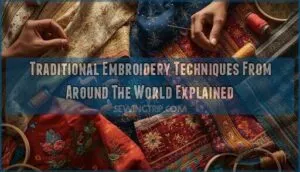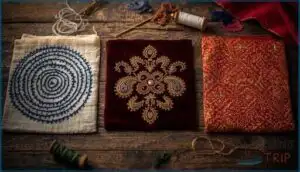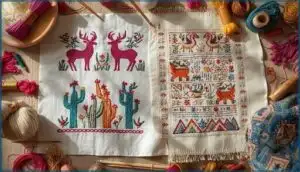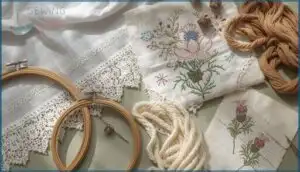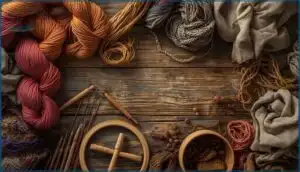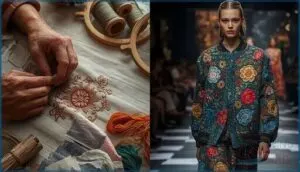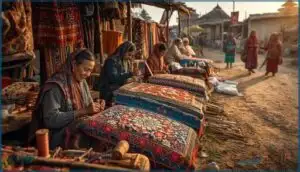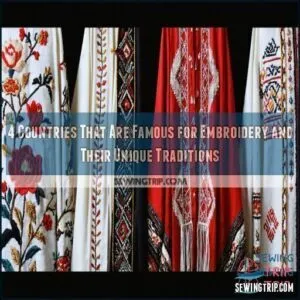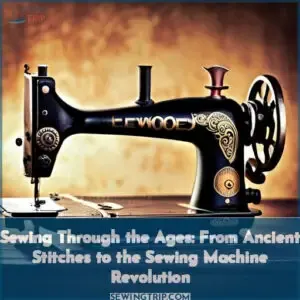This site is supported by our readers. We may earn a commission, at no cost to you, if you purchase through links.
A single thread can carry the weight of centuries. Across continents, artisans have transformed fabric into visual language, stitching gold into Indian bridal wear, weaving indigo patterns that mend Japanese work clothes, and embroidering vibrant creatures onto Mexican textiles.
These traditional embroidery techniques from around the world aren’t mere decoration—they’re coded messages, cultural archives, and survival skills passed through generations of hands. While fast fashion churns out identical patterns by the million, master embroiderers still guard regional methods that can take years to learn: the raised metalwork of Zardozi, the geometric precision of Sashiko, the symbolic geometry of Kente cloth.
Understanding these techniques means recognizing how communities have preserved identity, marked milestones, and created beauty under vastly different circumstances, from the silk courts of China to the cotton fields of West Africa.
Table Of Contents
Key Takeaways
- Traditional embroidery techniques like Indian Zardozi, Japanese Sashiko, and Mexican Otomi serve as cultural archives that encode identity, heritage, and survival skills through specific stitches, materials, and patterns unique to each region.
- These embroidery traditions generate substantial economic impact by empowering artisans—particularly women in rural areas—while connecting local craftsmanship to global markets worth billions of dollars through fair trade and digital platforms.
- Each technique reflects its geography and cultural values through deliberate material choices: Japanese Sashiko uses white cotton on indigo for functional beauty, while Indian Zardozi employs gold thread for royal prestige, and African Kente requires weeks of handweaving to create symbolic geometric patterns.
- Modern preservation efforts combine digital documentation, artisan training programs, and contemporary fashion collaborations to keep heritage techniques alive while adapting them for today’s markets, though challenges like cultural appropriation and economic pressures require careful navigation.
Key Embroidery Techniques Around The World
Embroidery traditions around the world reflect centuries of cultural expression, each region developing distinct techniques that tell their own stories. From the metallic threads of Indian Zardozi to the minimalist geometry of Japanese Sashiko, these methods showcase different approaches to transforming fabric into art.
You’ll find that understanding these key techniques opens a window into the diverse ways communities have preserved their heritage through needle and thread.
Indian Zardozi, Kantha, and Phulkari
India’s embroidery heritage reveals intricate artistry shaped by regional identity and artisan livelihoods. You’ll discover traditional embroidery techniques that face economic challenges yet remain essential to cultural preservation:
- Indian Zardozi: Persian-origin metalwork using gold thread, historically royal attire, now centered in Bareilly despite material sourcing difficulties and income decline
- Kantha: Bengali running-stitch recycling cloth into narrative archives
- Phulkari: Punjabi silk-floss geometric patterns on red fabric
- Modern Adaptations: Fair trade initiatives supporting contemporary market access
- Embroidery techniques: Handed down generationally, connecting heritage with today’s creative practice
The market is seeing substantial growth potential through 2031.
Chinese Su and Shu Embroidery
Moving eastward, you’ll find Chinese embroidery’s crown jewels in Su and Shu styles—both rooted in historical origins spanning 2,500+ years. Suzhou embroidery perfected “painting by needle” through 40+ stitch techniques manipulating silk threads for lifelike artistic motifs. Sichuan’s Shu embroidery employs 120 precise stitches creating vibrant pandas and koi. These styles are two of the Four Famous Embroideries recognized as National Intangible Cultural Heritage.
These traditional embroidery techniques generate substantial economic impact: Zhenhu alone sustains 11,000 people through family workshops, while preservation efforts include master-apprentice training and digital archives safeguarding cultural continuity.
Japanese Sashiko and Kogin
In Japan’s northern villages, you’ll discover Kogin patterns born from necessity—farmers’ wives counted odd-numbered stitches between fabric threads during the Edo period, transforming coarse linen into geometric works of art. Japanese Sashiko emerged similarly, using running stitches in white thread on indigo to mend garments.
These embroidery techniques embody the Mottainai concept—resourcefulness over waste—and modern adaptations now fuel market growth as both traditional embroidery styles evolve into contemporary fashion and home decor.
Mexican Otomi and Cross-Stitch
Across Mexico’s central highlands, you’ll encounter two distinct regional techniques. Mexican Otomi embroidery—known as tenangos—transforms white muslin through vibrant animal and plant motifs using nearly invisible blind stitches, with single pieces taking up to a year to complete. Meanwhile, Mexican cross-stitch arrived via nineteenth-century European influences, where counted-thread patterns now support artisan livelihoods.
Key characteristics you’ll notice:
- Otomi symbolism rooted in ancient cave paintings and local mythology
- Bright cotton threads contrasting sharply against neutral fabric backgrounds
- Cross-stitch influences blending indigenous aesthetics with European grid patterns
- Material choices emphasizing sturdy cotton, wool, and metallic threads for ceremonial use
African Kente and Hausa Embroidery
West Africa offers two powerful textile traditions that tell stories through thread and loom. Kente cloth symbolism emerges from Ghana’s Asante and Ewe peoples, where horizontal strip looms produce vibrant geometric patterns requiring three to four weeks per piece—authentic examples commanding over $500. Meanwhile, Hausa motifs reflect Nigeria’s spiritual values through intricate embroidery techniques and styles on traditional alkyabba robes.
Cultural preservation efforts now support economic sustainability through weaving and embroidery techniques, connecting African embroidery to global markets while maintaining traditional methods.
| Tradition | Primary Technique | Cultural Significance |
|---|---|---|
| Kente | Handweaving on strip looms | Royal attire, ceremonial prestige |
| Hausa Embroidery | Polychromatic threadwork | Religious identity, community values |
| Both | Symbolic motif systems | Economic empowerment, heritage preservation |
European Whitework and Crewel
European whitework styles—from Norway’s Hardanger to Scotland’s Ayrshire—use matching white thread on pale fabric to create elegant, intricate patterns.
Crewel embroidery takes a different path, employing worsted wool on linen with over twenty stitch variations.
These traditional embroidery techniques showcase regional differences across the continent, while modern adaptations now blend hand and machine methods to meet contemporary demand for these timeless embroidery styles.
Cultural Significance of Traditional Embroidery
When you look closely at traditional embroidery, you’ll find it’s never just about decoration. Every stitch, color, and pattern carries meaning that reflects the beliefs, values, and stories of the people who created it.
Let’s explore how embroidery functions as a powerful form of cultural expression across three key dimensions.
Symbolism in Motifs and Patterns
Every stitch carries meaning—motifs aren’t just decoration, they’re visual language. You’ll find geometric patterns like triangles symbolizing balance, while circles represent unity across cultures.
Floral symbolism ranges from roses expressing love to cherry blossoms reflecting life’s fleeting beauty. Animal symbolism adds depth too: phoenixes signal rebirth, doves bring peace.
This cultural iconography transforms fabric into storytelling, with cosmic patterns connecting earthly designs to universal beliefs.
Embroidery in Rituals and Ceremonies
Throughout history, you’ll encounter wedding embroidery and religious vestments marking life’s most sacred moments. Traditional embroidery techniques transform lifecycle rituals into tangible cultural heritage, where every thread reinforces status symbol traditions.
- Indian brides wear zardozi-embroidered lehengas glittering with gold, signaling prosperity
- Christian priests don ecclesiastical vestments featuring intricate metalwork denoting spiritual rank
- African Kente cloths display embroidered patterns revealing lineage during community ceremonies
- Mexican Otomi wedding dresses showcase colorful symbolic patterns celebrating cultural identity
This cultural significance of embroidery extends beyond aesthetics—the economic impact aids artisan communities preserving embroidery traditions while cultural symbolism connects generations through fiber and faith.
Embroidery as Cultural Storytelling
You’ll discover embroidery as a form of storytelling where threads carry cultural narratives across generations. Palestinian embroiderers encode identity markers through geometric motifs—95% reference them as symbols of ancestry—while Chinese dragons convey power through cultural symbolism in embroidery.
These symbolic motifs preserve oral traditions, with Kutch’s “eye” pattern documenting family migrations. Group stitching sessions enable emotional expression, transforming narrative preservation into shared cultural memory.
Embroidery’s symbolic motifs preserve oral traditions and family histories, transforming group stitching sessions into shared cultural memory across generations
Materials and Methods in Global Embroidery
The materials and methods you choose in embroidery aren’t just practical decisions—they’re deeply tied to geography, tradition, and regional availability. From the weight of the fabric to the twist of the thread, these choices shape the final piece and reflect centuries of local adaptation.
Let’s look at how different cultures approach the fundamentals of their craft.
Regional Fabric and Thread Choices
The materials you choose aren’t just practical decisions—they’re rooted in centuries of regional identity and symbolic tradition. Each culture’s fabric and thread sourcing reflects what grows nearby, what carries meaning, and what hands have skillfully worked for generations.
Consider these distinctive regional fabric embroidery choices:
- Indian embroidery ranges from cotton and muslin to luxurious silk threads and metallic threads, with Kashmir’s crewel work favoring wool on wool fabric
- Japanese Sashiko relies exclusively on white cotton thread against indigo-dyed cotton, creating functional beauty through contrast
- Mexican Otomi showcases vibrant symbolic materials—bright cotton thread on plain-weave cotton fabric representing local flora and fauna
- African traditions employ locally woven cloth with natural fabric dyeing using indigo, weld, and madder for distinctive blue and red shades
Regional fibers and weave characteristics fundamentally shape each tradition’s aesthetic and cultural expression.
Distinctive Stitch Techniques
Beyond fabric and thread, the stitches themselves carry cultural DNA. Stitch identification reveals how each region solved design challenges uniquely. Japanese Sashiko’s running stitch constitutes 75% of its stitchwork, while Indian Kantha relies on chain and running stitches in over 80% of pieces. Cross-stitch dominates 40% of global counted-thread embroidery, though technique complexity varies dramatically.
| Stitch Type | Primary Regions | Cultural Characteristic |
|---|---|---|
| Chain Stitch | India, China, Mexico | Adaptable outlining, 30-40% of Otomi work |
| Running/Backstitch | Japan, India, Europe | Fundamental reinforcement, 50-75% usage |
| Satin Stitch | India, China, Africa | Smooth coverage, 35-60% of surface fills |
| Cross-Stitch | Europe, Mexico, Middle East | Geometric precision, 70% of Blackwork patterns |
Regional adaptations transform basic stitching techniques into distinctive artistic signatures. Mexican Otomi combines chain and satin stitches for vibrant animal motifs, while Japanese Kogin employs long-and-short stitching for 60% of its geometric designs. African Hausa embroidery incorporates satin stitch across 35% of ornamental surfaces, creating raised textures that catch light differently than flat European Whitework, where backstitch outlines comprise 40% of traditional patterns.
Modern stitchwork continues evolving these traditional embroidery techniques. French knots add texture to floral motifs globally, representing roughly 12% of decorative elements. Machine-made satin stitches have increased 25% since 2020, yet hand embroidery maintains irreplaceable cultural authenticity. Stitch variations within each tradition—like Middle Eastern Shadeed cross-stitch or Indian Zardozi’s raised knots—demonstrate how technique complexity deepens with mastery, connecting contemporary crafters to centuries of embroidery techniques around the world.
Tools and Embroidery Frames
Frame evolution reflects technological adaptation in traditional embroidery techniques. You’ll find wooden hoops from 17th-century India alongside contemporary magnetic frames, which now capture 20% of specialist markets for heavy fabrics.
Sustainable materials like bamboo account for 12% of 2025 sales, while automation impact shows 90% time savings with modern hooping systems.
Market trends indicate eco-conscious embroidery tools growing 18% since 2022, supporting both heritage and innovation.
Modern Adaptations and Preservation Efforts
Traditional embroidery isn’t stuck in the past—it’s evolving right alongside modern design, fashion, and global markets. Artisans and designers are finding creative ways to keep these centuries-old techniques alive while making them relevant for today’s world.
You’ll see how heritage stitches are being revived, adapted into contemporary fashion, and blended with new styles to honor tradition without losing its soul.
Reviving Heritage Techniques
As heritage embroidery traditions face the risk of disappearing, targeted initiatives are bringing traditional embroidery techniques back to life. Digital documentation now preserves cultural heritage through coded identification systems and archival photography, ensuring cultural authenticity for future generations. Meanwhile, sustainable practices are strengthening economic viability for artisans through strategic partnerships.
- Artisan skill-sharing: Over 1,000 rural women across 11 countries have benefited from revival programs, with the IBU Foundation raising over USD 200,000 to support cultural preservation projects.
- Knowledge transmission: Gujarat’s Pride and Enterprise project documented 1,082 hand-embroidered panels in 16 regional embroidery styles over six years.
- Sustainable impact: The STRIE Method, integrating Toda embroidery, has created opportunities for over 300 women artisans while aligning with UN development goals.
These coordinated efforts guarantee that embroidery traditions don’t just survive—they flourish, supporting communities while maintaining the integrity of centuries-old craftsmanship.
Embroidery in Contemporary Fashion
As traditional embroidery techniques find new life in fashion, you’ll see runway embroidery transforming haute couture with statement pieces requiring 600+ artisan hours. Modern fashion embraces digital embroidery and AI design to analyze trends, while sustainable threads and eco-friendly methods are up 27% since 2021. Customization demand drives 28% annual growth, making embroidered garments central to sustainable fashion branding across luxury and mass markets alike.
| Technology Impact | Sustainability Growth | Market Response |
|---|---|---|
| 35% firms use digital embroidery | 27% increase in organic materials | 28% customization growth yearly |
| AI predicts color trends | 16% annual workshop expansion | 41% search interest rise |
| USB design import standard | Reduced water/chemical use | $6.2B market by 2032 |
| 250,000 sequins possible | Recycled thread adoption | 22% client retention boost |
Fusion of Traditional and Modern Styles
When traditional embroidery techniques meet modern technology, you witness motif integration that honors heritage while embracing innovation. Today’s technique blending merges cultural patterns with sustainable practices, as 64% of embroiderers intentionally incorporate ancestral designs into contemporary work.
Market trends show fusion pieces driving 67% collection growth, though cultural appropriation concerns require respectful collaboration.
Embroidery in fashion now balances authenticity with creativity through thoughtful color palettes.
Economic and Social Impact of Embroidery
Beyond its artistic and cultural value, embroidery is important in influencing economies and communities around the world. From enabling rural artisans to driving billion-dollar markets, this craft touches lives in ways that extend far beyond the needle and thread.
In this section, you’ll see how embroidery aids livelihoods, connects local traditions to global commerce, and preserves cultural heritage through education.
Empowerment of Artisans and Women
You’ll find that traditional embroidery isn’t just preserving cultural heritage—it’s breaking barriers for women worldwide. In rural India and Bangladesh, where female participation exceeds 80% in the handicraft sector, women transform their skills into economic empowerment through artisan economic growth.
Consider these powerful impacts:
- Financial Independence: Women invest earnings in education, achieving self-sufficiency while practicing traditional craftsmanship
- Gender Equality Promotion: Challenging patriarchal norms by becoming primary wage earners in their families
- Skill Development Impact: Training programs build business knowledge, digital marketing, and entrepreneurial capabilities
- Cultural Heritage Preservation: Women artisans safeguard techniques like Kantha and Chikankari across generations
- Overcoming Structural Barriers: Despite facing middlemen exploitation and limited credit access, artisans persist through cooperatives and fair trade organizations
These embroidery and women’s empowerment initiatives prove that traditional needlework creates pathways to economic and social transformation for artisans globally.
Embroidery in Local and Global Markets
As consumer demand for authentic handcrafted pieces surges, you’re witnessing embroidery transform from village workshops into a USD 3.71 billion global market.
Export dynamics now connect artisans across India, Peru, and Nigeria to international buyers through ecommerce platforms, enabling market access that was unimaginable decades ago.
This financial impact drives economic empowerment while fostering cultural exchange, proving traditional needlework thrives in contemporary business models.
Educational Initiatives and Cultural Preservation
You’ll discover how UNESCO Safeguards have formalized cultural preservation through structured Artisan Training programs, reaching over 350 practitioners across twelve Mexican municipalities since 2024.
Curriculum Integration now brings traditional embroidery into schools, while Digital Archives document techniques for future generations.
These initiatives measure Cultural Significance through Impact Assessment tools, ensuring Cultural Heritage survives and artisans gain recognition for their contributions to living textile traditions.
Frequently Asked Questions (FAQs)
How do I start learning traditional embroidery?
You can start with affordable starter kits priced around $20-$45, then explore online tutorials to master core stitches like backstitch and satin stitch.
What are the best fabrics for beginners?
You’ll want quilting cotton fabric or Aida cloth for embroidery for beginners. Linen blends work well too.
Choose medium fabric weight and a tight weave, avoiding pitfalls like stretchy materials that distort embroidery stitches and techniques using embroidery threads on fabric embroidery projects.
How long does hand embroidery typically take?
Hand embroidery duration depends on design complexity, stitch density, and skill level. Small motifs take one to three hours, while medium projects require six to twelve hours.
Material impact and project size also greatly affect timing.
Can traditional patterns be legally reproduced commercially?
Can you legally sell those patterns you found? Copyright expiration, Indigenous protections, and cultural heritage laws complicate commercial reproduction.
Fair compensation for artisans, ethical sourcing, and legal enforcement safeguard cultural identity and traditional embroidery’s cultural significance.
Where can authentic traditional embroidery supplies be purchased?
You’ll find authentic traditional embroidery materials through regional suppliers, online marketplaces like Etsy, and fair-trade initiatives supporting artisans.
Artisan co-ops offer certified materials while preserving handcraft techniques tied to cultural embroidery traditions.
Conclusion
Every stitch carries a history. Every pattern holds a purpose. Every thread connects you to artisans who’ve shaped cultural identity through needle and fabric for generations. These traditional embroidery techniques from around the world aren’t relics—they’re living practices that continue evolving in skilled hands.
When you recognize the distinction between Zardozi’s metallic opulence and Sashiko’s functional geometry, you’re not just learning craft terminology. You’re decoding the visual languages that communities used to survive, celebrate, and remember.
- https://saantha.com/blogs/updates/embroidery-traditions-around-the-world
- https://nwcustomapparel.net/history-of-embroidery/
- https://blog.fabrics-store.com/2021/10/28/embroidery-from-around-the-world-an-introduction/
- https://www.iiardjournals.org/get/RJHCS/VOL.%2011%20NO.%203%202025/Empowering%20Tradition,%20Enriching%2078-83.pdf
- https://dataintelo.com/report/embroidery-market

